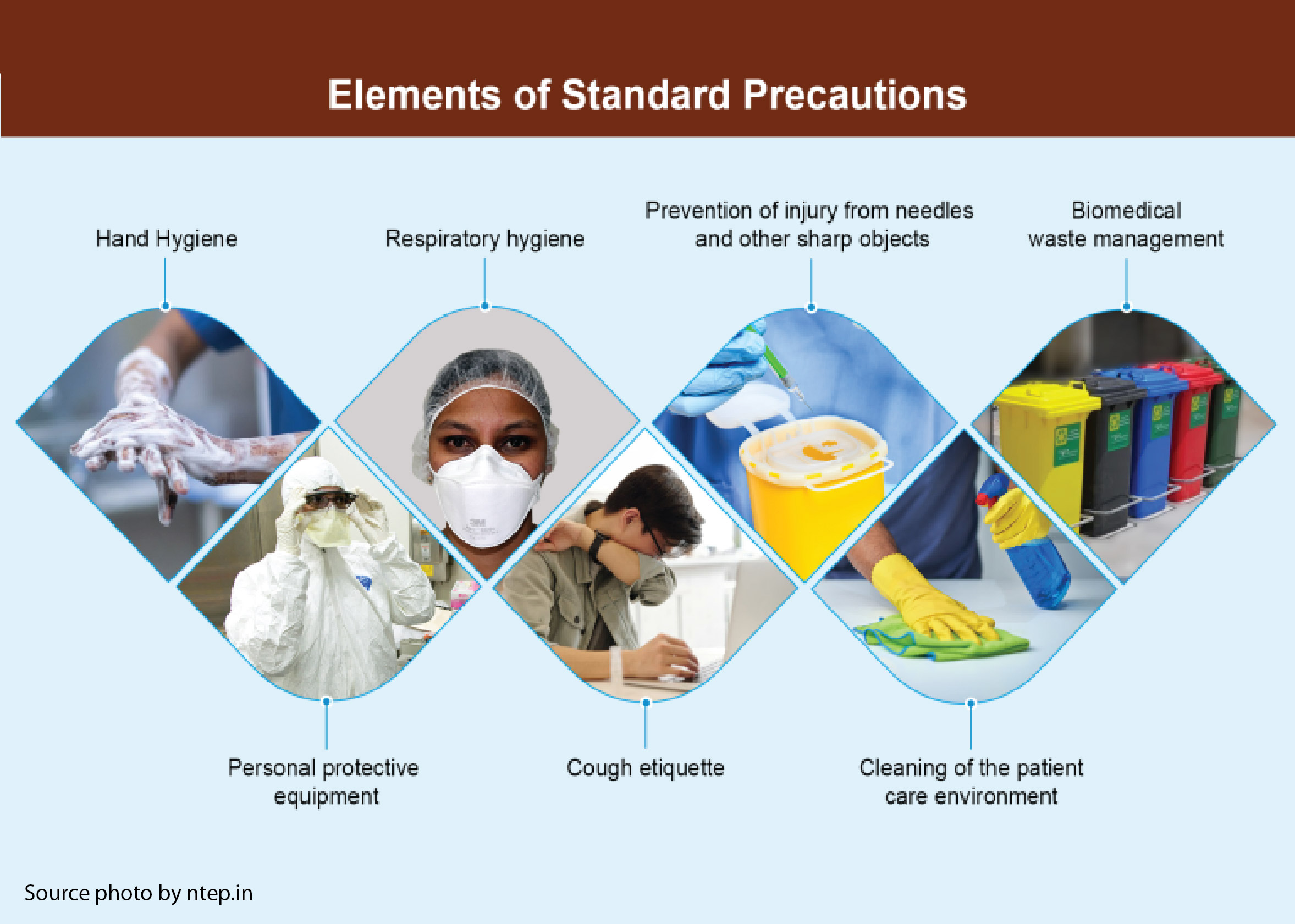THE RELATIONSHIP OF ORGANIZATIONAL FACTORS AND COMPLIANCE LEVEL IN THE APPLICATION OF STANDARD PRECAUTIONS

Downloads
Background: Infection prevention around health care facilities is one of the efforts to minimize infection in patients, officers, visitors, and communities. One of the efforts to prevent infection is to apply standard precautions. Purpose: To determine the effect of organizational factors on the level of compliance of health workers in implementing standard precautions. Method: There were 83 respondents. The sampling technique uses simple random sampling. The dependent variable is the level of compliance with the application of standard precautions. The independent variables are policies, procedures, facilities, training, monitoring, and safety climate. Data analysis using correlation test and regression test to determine the effect between variables. Result: There was a relationship between facilities and the level of compliance (p = 0.030), there was a relationship between training and compliance (p = 0.027), there was a relationship between the safety climate and the level of compliance (p = 0,009). The influence test shows that the climate safety factor (p = 0.007) and facilities (p = 0.020) have a significant effect on the level of compliance. Conclusion: There is a relationship between facilities training and safety climate with the level of compliance of officers in the application of standard precautions in hospitals. The factor that most influences the level of compliance with the application of standard precautions is the safety climate.
Abuduxike, G., Acar Vaizoglu, S., Asut, O., Cali, S., 2021. An Assessment of the Knowledge, Attitude, and Practice Toward Standard Precautions Among Health Workers From a Hospital in Northern Cyprus. Saf. Health Work 12, Pp. 66–73.
Ayu, B.F., Tualeka, A.R., Wahyudiono, Y.D.A., 2018. The Analysis of Factors which are Related to The Compliance of Welder Workers in using Workplace Personal Protective Equipment in PT. PAL Indonesia. Indian J. Public Heal. Res. Dev. 9, Pp. 47-52.
Candra, A., 2015. Hubungan Faktor Pembentuk Perilaku dengan Kepatuhan Penggunaan Alat Pelindung Telinga pada Tenaga Kerja di PLTD Ampenan. IJOSH (The Indones. J. Ocuupational Saf. Heal. 4, Pp. 83-92.
Cooper, C.L., Dewe, P.J., O'Driscoll, M.P., 2001. Organizational Stress: A Review and Critique of Theory, Research and Applications, 1 st. ed. SAGE Publications, Inc., United States.
Cronk, R., Bartram, J., 2018. Environmental Conditions in Health Care Facilities in Low- and Middle-Income Countries: Coverage and Inequalities. Int. J. Hyg. Environ. Health 221, Pp. 409-422.
Damanik, S.M., Susilaningsih, F.S., Amrullah, A.A., 2012. Kepatuhan Hand Hygiene di Rumah Sakit Immanuel Bandung. Students e-Journal 1, Pp. 1-14.
Givi, B., Schiff, B.A., Chinn, S.B., Clayburgh, D., Iyer, N.G., Jalisi, S., Moore, M.G., Nathan, C.A., Orloff, L.A., O'Neill, J.P., Parker, N., Zender, C., Morris, L.G.T., Davies, L., 2020. Safety Recommendations for Evaluation and Surgery of the Head and Neck during the COVID-19 Pandemic. JAMA Otolaryngol. - Head Neck Surg. 146, 579–584.
Gultom, A., Umboh, J.M.L., Polii, B., 2016. Faktor-Faktor yang Berhubungan dengan Penerapan Kewaspadaan Universal (Universal Precaution) oleh Perawat di Ruang Rawat Inap Penyakit Dalam (Irina C) RSUP. PROF. Dr. R. D. Kandau Manado. Paradig. Sehat 4, Pp. 29-42.
Guo, Y.L., Jijan, P.H., Luo, W.Z.Y., 2010. Factors Impacting Compliance with Standard Precautions in Nursing, China. Int. J. Infect. Dis. 14, Pp. e1106-e1114.
Iswanti, T., Nurdiati, R.D.S., K, H.F., 2018. Pengaruh Pengetahuan dan Masa Bekerja Bidan Terhadap Pelaksanaan Universal Precaution pada Pertolongan Persalinan di Wilayah Kota Tangerang Selatan. J. Med. (Media Inf. Kesehatan) 5, Pp. 21-29.
Kasa, A.S., Temesgen, W.A., Workineh, Y., Tesfaye, T.D., Kerie, S., Amsalu, E., Awoke, S.E., 2020. Knowledge Towards Standard Precautions among Healthcare Providers of Hospitals in Amhara region, Ethiopia, 2017: A Cross Sectional Study. Arch. Public Heal. BioMed Cent. Ltd 78, Pp. 1-8.
Kementrian Kesehatan RI, 2017. Peraturan Menteri Kesehatan Republik Indonesia Nomor 27 Tahun 2017 Tentang Pedoman Pencegahan Dan Pengendalian Infeksi Di Fasilitas Pelayanan Kesehatan 2017.
Kermode, M., Jolley, D., Langkham, B., Thomas, M.S., Holmes, W., Gifford, S.M., 2005. Compliance with Universal/Standard Precautions among Health Care Workers in Rural North India. Am. J. Infect. Control 33, Pp. 27-33.
Lelonowati, D., Koeswo, M., Rochmad, K., 2015. Faktor Penyebab Kurangnya Kinerja Surveilans Infeksi Nosokomial di RSUD Dr. Iskak Tulungagung. J. Kedokt. Brawijaya 28, Pp. 186-194.
Lim, S.H., Bouchoucha, téphane L., Aloweni, F., Suhari, N. 'Azzah B., 2021. Evaluation of Infection Prevention and Control Preparedness in Acute Care Nurses: Factors Influencing Adherence to Standard Precautions. Infect. Dis. Heal. 26, Pp. 132-138.
McGovern, P.M., Vesley, D., Kochevar, L., Gershon, R.R.M., Rhame, F.S., Anderson, E., 2020. Factors Affecting Universal Precautions Compliance. J. Bus. Psychol. 15, Pp.149–161.
Nichol, K., McGeer, A., Bigelow, P., O'Brien-Pallas, L., Scott, J., Holness, D.L., 2013. Behind The Mask: Determinants of Nurse's Adherence to Facial Protective Equipment. Am. J. Infect. Control. Elsevier Inc 41, Pp. 8-13.
Porto, J.S., Marziale, M.H.P., 2016. Reasons and Consequences of Low Adherence to Standard Precautions by The Nursing Team. Rev. Gauch. Enferm. 37, Pp. e57395.
Ramli, S., Djajaningrat, H., Praptono, R., Priyadi, K., 2010. Manajemen Risiko: Dalam perspektif K3 OHS Risk Management. Dian Rakyat, Jakarta.
Saadi, R.A., Bann, D. V., Patel, V.A., Goldenberg, D., May, J., Isildak, H., 2020. A Commentary on Safety Precautions for Otologic Surgery during the COVID-19 Pandemic. Otolaryngol. - Head Neck Surg. (United States) 162, Pp. 797–799.
Satiti, A.B., Wigati, P.A., Fatmasari, E.Y., 2017. Analisis Penerapan Standard Precautions Dalam Pencegahan dan Pengendalian HAIS (Healthcare Associated Infections) di RSUD Raa Soewondo Pati. J. Kesehat. Masy. Univ. Diponegoro 5, Pp. 40-49.
Suyono, K.Z., Nawawinetu, E.D., 2013. Hubungan antara Faktor Pembentuk Budaya Keselamatan Kerja dengan Safety Behavior di PT. DOK dan Perkapalan Surabaya Unit Hull Constraction. IJOSH (The Indones. J. Ocuupational Saf. Heal. 2, Pp. 67-74.
Wong, E.L.-Y., Ho, K.-F., Dong, D., Cheung, A.W.-L., Yau, P.S.-Y., Chan, E.Y.-Y., Yeoh, E.-K., Chien, W.-T., Wong, F.L.-Y., Ho, K.-F., Dong, O., Cheung, nnie W.-L., Yau, P.S.-Y., Chan, E.Y.-Y., Yeoh, E.-K., Chien, W.-T., Chen, rank Y., Poon, S., Zhang, I., Yeung-Shan, S., Chen, W.Y., Poon, S., Zhang, I., Wong, S.Y.-S., 2021. Compliance with Standard Precautions and Its Relationship with Views on Infection Control and Prevention Policy among Healthcare Workers during COVID-19 Pandemic. Int. J. Environemental Res. Publich Heal. 18, Pp. 3420.
Yoon, E.-J., Park, Y.-M., 2018. Factors Influencing Nursing Students' Performance of Standard Precaution for Healthcare-Associated Infection Control. J. Converg. Inf. Technol. 8, Pp. 19-27.
Yotlely, A.S., 2019. Analisis Faktor Yang Berhubungan Dengan Kepatuhan Perawat Dalam Penerapan Kewaspadaan Standar Di RSUD Piru 2, 170.
Copyright (c) 2021 Journal of Vocational Health Studies

This work is licensed under a Creative Commons Attribution-NonCommercial-ShareAlike 4.0 International License.
- The authors agree to transfer the transfer copyright of the article to the Journal of Vocational Health Studies (JVHS) effective if and when the paper is accepted for publication.
- Legal formal aspect of journal publication accessibility refers to Creative Commons Attribution-NonCommercial-ShareAlike (CC BY-NC-SA), implies that publication can be used for non-commercial purposes in its original form.
- Every publications (printed/electronic) are open access for educational purposes, research, and library. Other that the aims mentioned above, editorial board is not responsible for copyright violation.
Journal of Vocational Health Studies is licensed under a Creative Commons Attribution-NonCommercial-ShareAlike 4.0 International License














































